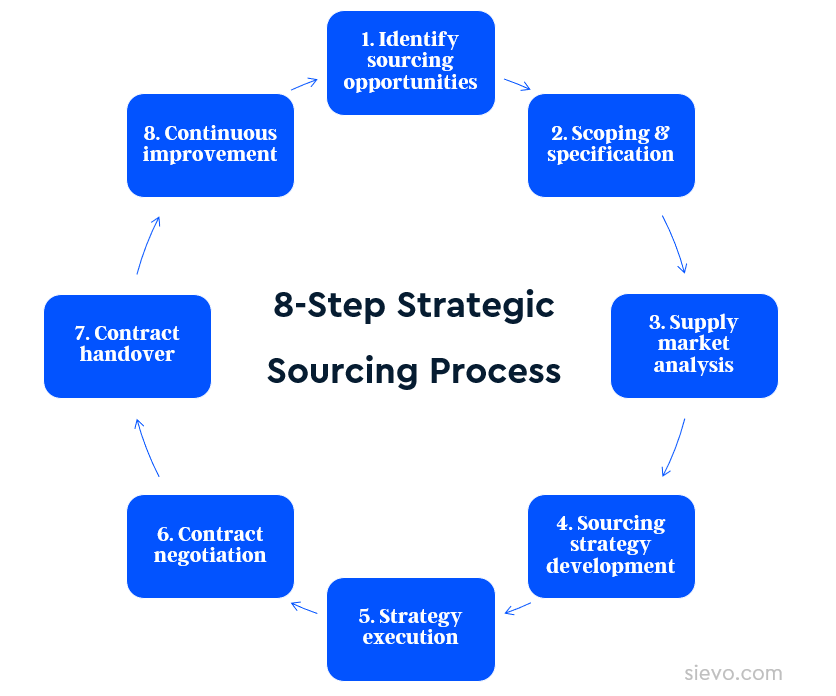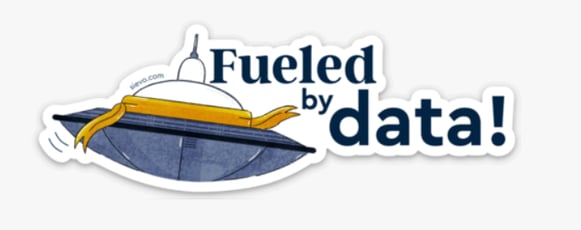Strategic sourcing has a vital role to play in supply chain management and ensuring profitable business performance.
The main focus of strategic sourcing is to achieve the highest value with the lowest total cost of ownership (TCO) and supply risk.
Strategic sourcing includes developing proactive, holistic, and continuous evaluation and improvement of sourcing strategy and activities.
The best sourcing managers know their numbers, suppliers, and supply markets. They have an eye for finding new opportunities to create business value.
Without reliable data making sourcing decisions is a shot in the dark. This blog post covers how procurement data analytics can fuel your strategic sourcing process.
Jump ahead:
What is strategic sourcing?
Strategic sourcing is a structured process used to source key goods and services. It was originally developed by A.T. Kearney, and has been tested and proven effective over three decades, with adaptations.
Strategic sourcing is an important element within procurement category management. In large organizations, category management directs all the activities within a category group to support the greater business agenda and strategy.
Historically, it was mainly applied to drive price reductions to meet savings goals using the total cost of ownership approach. But today, the strategic sourcing process considers continuity of supply, manages risk, and supports sustainability goals and supplier development.
Sourcing vs. procurement
The words procurement and sourcing are often used side by side. Procurement refers to the entire acquisition process of goods and services, including sourcing, contracting, purchasing, goods receiving and inspecting, and keeping records of all transactions.
Sourcing is a key part of the procurement process. Strategic sourcing includes various sourcing activities from opportunity identification to supplier relationship development.
The term purchasing or operational procurement refers to tactical or transactional activities such as purchase ordering and invoice handling.
The role of a strategic sourcing manager
The responsibility of a strategic sourcing manager is to develop and execute a sourcing strategy for a specific category of goods and services.
The aim is to negotiate and implement efficient and cost-effective supply contracts that meet the stakeholder requirements.
They can find sourcing opportunities from risk mitigation, process improvements, cost savings, or quality management.
To identify areas of opportunity, they will analyze historical activity, transactions, and costs. Strategic sourcing projects that involve large quantities of data benefit greatly from the application of analytics solutions.
The benefits of procurement data in sourcing
Sourcing is often seen as a combination of sophisticated analysis of data and strategic planning. It's almost like an art form (according to sourcing managers themselves).
Successful strategic sourcing projects are driven by data. This includes more than just historical spending. Data in the sourcing process can help improve:
- product and service quality,
- on-time delivery,
- optimizing the ordering process,
- benefitting from volume-based discounts,
- managing relationships,
- and identifying potential issues throughout the contract term.
Using spend analytics in strategic sourcing
Spend analytics enables sourcing professionals to identify trends, market changes, performance issues, consolidation opportunities, and sourcing potential.
It can be used to identify sourcing categories, segment suppliers, and narrow down critical suppliers for development programs.
Spend analytics provides superpowers to sourcing managers compared to working with multiple datasets and pieces of information!
The strategic sourcing process with data
Integrating analytics into the sourcing process typically involves collecting data from many different source systems such as ERPs and various stand-alone systems and files, including those that track supplier actions and behaviors.
The data, when classified and verified can be displayed on a visual dashboard or within business intelligence tools as a basis for launching any strategic sourcing project and assessing the effectiveness of past sourcing decisions.
Here's a breakdown of how data can be used in each step of the strategic sourcing process.

1. Identify sourcing opportunities
👉Use data to analyze spend and identify sourcing opportunities.
Spend visibility is the key to understanding the category and the commodities in it. Data must be sorted, cleansed, analyzed, and finally validated.
Spend analysis can reveal opportunities for consolidation, trends in material prices, delivery performance challenges, or simply areas of spend that could benefit from favorable market changes.
2. Scoping and specification
👉Use data to develop the spend profile, specifications, and service level requirements.
Define the sourcing category, service, or commodity including the volumes, current suppliers, and key specifications. Identify patterns and seasonal variations.
Who are the end-users, where are they located, what are the logistics used, and who else is involved in the supply chain? Involve your stakeholders in the specification phase!
3. Supply market analysis
👉Use data to analyze the supply market, identify potential suppliers, spend trends, and effective contract mechanisms.
Study the cost elements that make up the product or service, also called cost drivers. Source key market prices (or use material forecasting software!) and other cost elements such as labor and transportation. Use these later to evaluate and benchmark offers.
Investigate the external supply market to look for potential new or alternative global and local suppliers. Sometimes this phase can turn into a build-or-buy analysis if there are not enough reliable suppliers available for a business-critical service or product.
4. Sourcing strategy development
👉Develop sourcing strategy together with business stakeholders based on spend analysis, requirements, identified opportunities, and market analysis.
Your sourcing action plan may be renegotiating an existing contract or entering into an RFx process...
The strategy will depend on what alternatives there are and how competitive the marketplace is. Understanding your overall buying power will help choose the right strategy for you.
Sometimes developing the existing supplier relationship is the most beneficial option for both parties. Sometimes shaking the dynamics a little help in improving service level and paying the right price for the product or service.
5. Strategy execution
👉If there is potential in the market, structure and issue an RFx that meets your current and future needs.
The most common method of approaching the market is to use a Request for Proposal (RFP). Conduct a Proof of Concept (POC) and audit as part of the process if needed.
Sometimes RFx can be used to gather more information and validate your current contractual set-up. As a result, you might find out that your current supplier and contract is the one that still best serves your needs. RFPs must clearly define the specifications and include the service requirements, contract terms and conditions, and any other specific requirements.
Evaluate proposals using weighted scoring. The evaluation criteria should be decided before entering the RFP for fair assessment. Shortlist qualifying suppliers, and then interview for clarification or more details if needed.
6. Contract negotiation
👉Leverage spend data and insights in negotiation for the best TCO.
Negotiate with the preferred supplier. The process of selecting a supplier may include conducting multiple rounds of negotiations with suitable short-listed potential suppliers.
You could use the market indexes to challenge pricing or information on alternative service models and proposals to challenge service quality.
7. Contract handover and implementation
👉Eliminate maverick spending by streamlining the purchase order (PO) process.
Ensure that the internal end-users and stakeholders affected are involved in the final decision.
Implement contract and process changes, onboard supplier, and assign relationship lead (KAM). Smooth implementation is only possible with extensive communication and a strong focus on change management, especially for complex agreements.
8. Continuous improvement with SRM
👉Manage spend and identify opportunities during the contract term. Manage performance and relationship for the best value.
Supplier Relationship Management (SRM) plays a big part in realizing the benefits of a contract. Constant management of spend ensures that full contract value is achieved from the contract.
Failing in SRM and spend management will not only mean lost savings but will promote the practice of maverick spending. Market conditions are not static.
You should actively focus on the continuous improvement of products, processes, and services. A contract is a living document that should be updated as needed.
Strategic sourcing fueled by procurement data
Sievo has partnered with a number of sourcing solution providers, such as Archlet, Market Dojo, Scanmarket, and QAD Allocation. Visit Sievo's Partners page for more information.
Don't hesitate to book a demo to discuss the available solutions, and how spend analytics can support your sourcing team to identify potential and make better decisions faster!

Header photo by: @raimondklavins (unsplash.com)




